How To Garden Hose Reel

Garden hoses are unremarkable when they work well, but if they underperform, they'll drive you insane. After several years of testing—washing cars, gardening, pressure washing driveways, and doing other hosey home chores—we found the Dramm ColorStorm Premium Rubber Hose (50 feet) is the all-purpose garden hose we'd invest in. It's not perfectly kink-proof—none of them are—but its sturdiness and dependable performance go far beyond that of the twisted, knotted, worthless garbage hoses that probably inspired you to search for something better.
Our pick
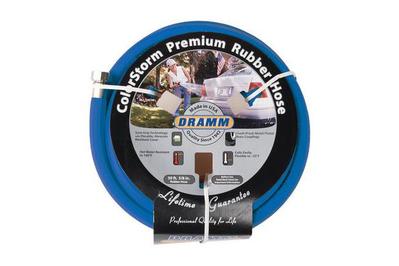
The Dramm ColorStorm Premium Rubber Hose (50 feet) is far from being the cheapest hose you'll ever find, but after testing the bargain models and the midrange options, we're convinced the best value in a garden hose is the one you can buy once and use indefinitely. The Dramm's uncrushable nickel-plated brass couplings have big flat facets you can grip with a wrench or locking pliers to break a stuck connection. Although the lifetime warranty and solid customer support are reassuring, we're confident (after our own tests and customer anecdotes about long-term use) that you may never need to take Dramm up on it. Durable and versatile, this hose is perfect for all kinds of utility work (even though it can be a bit of a beast if you're just quickly watering a small patio garden).
Also great

It's not quite as polished on all the details as our pick, but the Continental Commercial Grade Rubber Hose (50 feet) is an excellent value: It's tougher than the cheapest hoses by a mile, and for not much more money. The Continental resembles a Craftsman rubber hose we've recommended for years in this guide. Though that model has become hard to find, the Continental now has nearly ubiquitous availability at home centers and hardware stores. Like the Dramm, the Continental can feel like overkill for small watering jobs, but it's a really solid choice for anyone who wants something that's reliable, not too fussy, and durable enough for any landscaping, maintenance, or construction work.
Also great
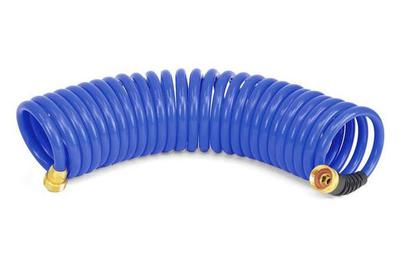
The HoseCoil ⅜-inch Self Coiling Garden Hose (25ft) is neither as tough nor as long as our other picks, but for a small patio, balcony, or yard—where dragging around a big 50-footer feels like overkill—it's a fine alternative. The HoseCoil's main selling point is its retractable corkscrew design, which works as advertised in making the hose easy to extend, recoil, and store. Compared with our bigger picks, this ⅜-inch-diameter hose loses a quarter-inch of capacity, which translates to slightly lower water pressure in side-by-side trials. Although the HoseCoil's total length is 25 feet, in practice it's really good for only about 17 feet before it starts to strain. As with our heavier-duty picks, the HoseCoil's nozzle end has flat facets for a wrench to grab. And its two-year warranty is reassuring; though we've heard of some HoseCoils lasting longer, hitting the two-year mark is about what we'd expect. We have a test unit that's doing fine after months of continuous Southern California sun exposure.
Also great
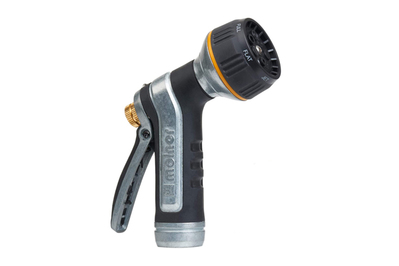
For a full-featured hose nozzle that can shower delicate flowers just as well as it can blast the mud off a truck tire, we recommend the Melnor 65020-AMZ Metal Nozzle. You can find a lot of similar nozzles, but the Melnor stands out due to its durable construction and its good variety of spray patterns, as well as how nicely it sprays. The Melnor has a hefty metal body with a hard rubber padding at the grip area (the spraying nozzle itself is plastic). It has seven spray patterns that run the gamut from a car-rinsing jet stream to a mist that can water even the most delicate seedlings. Compared with six other nozzles we recently tested, the Melnor not only felt the most durable but also had a spray that was simply better: The shower setting was a perfect shape with hardly any spitting, the jet setting shot water the farthest, and we never saw any dripping out of the front of the nozzle. This pick replaces the Melnor 5-Pattern Watering Nozzle 301-416, which has had a lot of leaking issues (including a specific event when it leaked and drained Wirecutter senior staff writer Doug Mahoney's well completely dry).
Also great
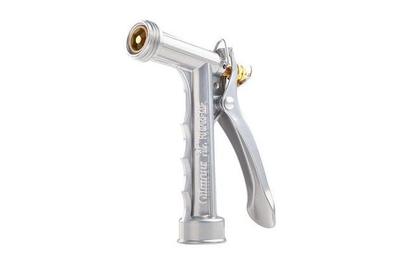
The classic Gilmour Full Size Zinc Pistol Grip Nozzle is a longtime Wirecutter recommendation that further proves five bucks is plenty to spend for a satisfying hose nozzle, as long as you're willing to make a concession or two. This tool contains none of the plastic parts common to competitors in its price range, and it lacks the familiar rotating wheel of spray settings. Instead, when you depress the trigger, you get a range of sprays—from a mistlike cloud, at minimal pressure, on up to a forceful jet, when the trigger is fully depressed. You can adjust a setting screw to customize this range slightly, but it's nowhere near as targeted as the settings on the Melnor model. That doesn't matter much when you're washing the car (which the Gilmour is perfect for). But the Gilmour can be frustrating to use when you're trying to water small container plants: You'll spray water everywhere, and when you're correcting that, you might shoot a beam of water at the base of a plant, blasting dirt and damaging roots. We've been using versions of this tool for the better part of a decade, taking horrible care of them all the while (they still work fine). And we've confirmed in testing in 2021 that a new Gilmour is still as solid and reliable as the ones we bought years ago.
Budget pick
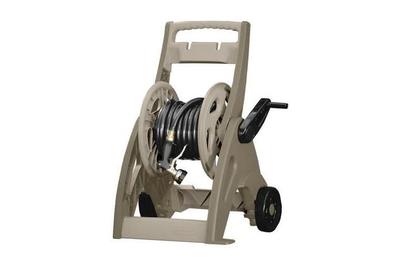
No one looking at the Suncast Hosemobile Hose Reel Cart would think they were viewing the Rolex of lawn gear, but what you see is what you get (in a good way). With a "durable rust-free resin" body, the Suncast is all plastic—from the threaded connections to the wheel hubs—and when you're cranking up a heavy hose, you can feel it flexing under the strain. That's okay with us and most everyone else who buys it, though: Usually sold for around $30, it's a far better value than the other reels in its price category. And since the Suncast gives you such an easy way to crank up, drain out, and properly store your hose, you're prolonging the hose's life, not to mention making your watering work easier.
Although the Suncast's wheels are convenient for moving your gear in and out of storage, we wouldn't recommend treating this reel like a rugged all-terrain vehicle. And we found that the Suncast works best when it's parked in one spot, rather than routinely being rolled around from spigot to spigot.
Upgrade pick
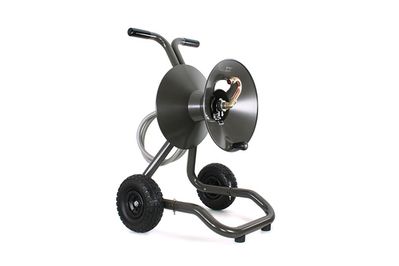
The Suncast reel works fine, but with regular use, year after year, its limitations—the quality, stability, and small wheels—may become frustrating. For a far superior reel, we recommend the Eley Portable Garden Hose Reel Cart, or if you prefer a wall-mounted version, the Eley Wall Mount Garden Hose Reel. In the world of hose reels, Eleys have a stellar reputation, and after testing one, we fully understand why.
The build quality of the Eley reel is as good as it gets; the strong metal frame provides stability, the giant tires easily bounce over an uneven lawn, the handles are comfortable and well-placed, and the reel itself pulls in a hose with minimal effort. The components are heavy-duty, and it's an item that we expect would last a lifetime, with proper care.
Everything we recommend
Our pick

Also great

Also great

Also great

Also great

Budget pick

Upgrade pick

Who this is for
The ruins of Roman aqueducts have pretty well established humankind's need to transport water, so it's not necessary to list the humble garden hose's many uses, from agriculture to yardwork (we couldn't think of a z word). Let's focus instead on who will find this guide useful. It's for anyone who has felt the impotent dribble of a hopelessly tangled hose, crushed a flimsy coupling beneath a car wheel, seen a cheap hose kink and fold like a deflated balloon, or watched water leak from a spigot connection that won't turn any tighter. If you've ever stood in your driveway while sweating and screaming at your hose, you are not alone, and we are here to help. Our goal is to recommend a versatile rig with all the spray patterns you'd ever need, in a setup that's so easy to use you'll be looking around the yard for something else to hose off.
How we picked

To find hoses worth testing, we started by looking at every popular model on the shelf and online at stores like Home Depot, Lowe's, and some local Ace franchises, and waded into the wider ocean of Amazon's offerings. We consulted with experts at the local home garden center, asked our neighbors and friends what they used, talked specs and materials with hose manufacturers, and examined the hardware at the finest car washes of East Los Angeles. We've also been using hoses our entire lives: Wirecutter senior editor Harry Sawyers is a former pro landscaper who now has several hoses snaking around his house in LA; Wirecutter associate staff writer Thom Dunn grew up adhering to his father's meticulous lawn-care regimen, which was the stuff of legends in Connecticut's New Haven County. In our reporting, a quote from our interview with Genevieve Schmidt—a garden writer and owner of a landscaping company in Northern California—was a common refrain: "Every hose brand will kink, but some brands are better than others."
That experience led us to demand just two strict criteria, both of which served as hallmarks of overall quality, reducing our test pool to a manageable number.
Flat facets at the couplings: We wanted a hose to have a nutlike hexagonal metal point in its coupling, the part that screws on to the spigot. This one feature, more than any other, is the thing that separates the good from the garbage. If the manufacturer has specified that detail (rather than a rounded, ridged coupling, like the cap of a soda bottle), it usually also means the hose's coupling has other features you'd want: It's unlikely to get crushed or deformed under a boot heel or car wheel, unlikely to corrode or lose its finish, unlikely to leak, and unlikely to get stuck—the whole point of those flat facets is to give you a place to put a wrench on it to free the hose when it's screwed on too tightly, your hands are too wet, or you're just too tired from busting your ass on yardwork all morning to disconnect the hose without a little mechanical advantage.
Made in the USA: This wasn't a requirement when we started our search, but it came to be a reliable barometer of quality, and not just for jingoistic reasons. If the hose is made in the USA, that almost definitely means the company is based in the USA, which takes customer service from being an abstract concept to a place you might actually be able to contact if you have a problem. When something is made in the USA, it often means you have a warranty. And it makes it more likely that the hose complies with casual industry programs like good manufacturing practice. Materials are more likely to be safe, nontoxic, authentic, or certified to meet FDA or NSF standards that apply to products related to potable water (like NSF/ANSI/CAN 61). Plus, more than most consumer products, garden hoses actually present a lot of US-made options for your consideration. We weren't closed off to the alternates, but considering the rich pool of candidates available within this class, we didn't feel we needed to look under every rock around the world for a marginally better option.
There were also a couple of common features that we didn't prioritize. We didn't really take claims of "kink-free or "kink-proof" seriously. We also didn't put stock in any claims of a hose's being "drinking water safe," even if the materials may be safe for water use in theory. The Dramm packaging sums it up well: "Garden hoses can come into contact with harmful chemicals often used with nozzles, garden sprayers, or chemicals used on lawns. The inside of the hose is dark, damp, and warm, causing bacteria to form." A hardware-store employee we interviewed about hoses recalled fond memories of youthful summer days spent lapping water from his parents' hose, and even though the Rockwell-esque image was lovely, we have better ways to drink water in the wild.
We didn't require a certain hose size, but our research steered us toward the standard, 50-foot length for general-purpose use. A 25-foot hose can barely run around a car and back, and a 100-foot hose can be difficult to handle, but a 50-footer should be enough to cover most suburban yards. If you need more than 50 feet, experts we spoke with recommended buying multiple hoses and connecting them—that way, if anything does break or leak, you have to repair or replace only one section, instead of buying another long, expensive hose. Most garden hoses come with a ⅝-inch diameter, so width wasn't a factor, although our tests did reveal subtle differences between the standard size and the smaller coiled option we considered.
How we tested
We've been testing garden hoses for years, in multiple locations. Our most recent tests encompassed months of use for routine home chores at Harry Sawyers's place in Los Angeles: pressure washing the grit off the driveway and patio furniture, washing the car, watering plants, filling kids' pools, and dousing the yard on July 4 (keeping our fingers crossed that a stray ember wouldn't set the bougainvillea ablaze). We put hoses on our most cramped spigots and measured any leaks from the connections. And as we whipped the hoses around the property, we paid attention to the texture of the hose material, along with the knots and tangles and general maneuverability.
Between using them, we drained and disconnected the hoses and re-coiled them, taking note of any memory (the tendency of an unrolled hose to retain its coiled shape) or any other stubbornness we encountered. In a 2019 test in Ithaca, New York, Thom Dunn dragged the hoses out to the street and drove a two-door Honda Civic back and forth over them several times, making sure to catch the fittings right beneath the wheels.

After peeling each flattened hose from the pavement, we put them through the same series of tests on the front and back spigots again, checking for leaks, ill-fitting fittings, or other damage.
In an even more brutal test, we put the hoses and nozzles in the hands of several ordinary children, between the ages of 3 and 7. Carried out mostly in backyard pool battles and other mayhem, this test allowed the kids to drop, grab, kick, bury, submerge, jam, and generally use the tools in ways no sane adult ever would. We probably voided the warranties on everything, but we had to do this to be sure these hoses and nozzles could handle true abuse.
In late 2020, we performed additional hose reel testing at a New Hampshire farm, where 100 feet of hose needs to be pulled out and reeled in on a daily basis.
Alongside the ongoing tests, we have been evaluating the long-term durability of all the products this guide has recommended over time. Torture tests are fun, but nothing can quite compare to the real-life rigors of coiling, uncoiling, stretching, and storing a hose, or the long-term degradation a hose endures over years of seasonal changes and sun damage. We've picked up a few tips on maximizing the life of a hose, too.
Also great: Continental Commercial Grade Rubber Hose (50 feet)

Also great

The Continental Commercial Grade Rubber Hose (50 feet) continues in the grand tradition of Indestructible Black Garden Hoses, among which we count our longtime pick, the Craftsman. The Continental simply happens to be widely available in 2020, whereas the Craftsman has gotten scarce. The Continental is thick, black, heavy, made in the USA, and widely available at Home Depot for about $30—less than the ColorStorm, more than the cheap trash, and really priced just about right for an excellent value. We found its kink resistance to be very comparable to the Dramm's: The Continental will kink if you force it to, but it will work reliably if you make an effort to keep it straight. This hose's brass couplings have generous facets for a wrench to grip, and in a minor flaw relative to the Dramm, the Continental's hardware lacks nickel plating and has a slightly less robust connection to the hose. Like the Dramm, the Continental is a beast to coil by hand, and its 50-foot length is a bit much for a small property, but it's a lot easier to manage with the aid of a good reel.
Also great: HoseCoil ⅜-inch Self Coiling Garden Hose (25ft)

Also great

The HoseCoil ⅜-inch Self Coiling Garden Hose (25ft) is not nearly as heavy-duty as our Dramm or Continental picks, but for a small patio or garden—where a big, 50-foot hose feels like overkill—it is a much more manageable option. This hose's primary distinction is its corkscrew-shaped coil, which extends to about 17½ feet of its full 25-foot length when in use, then springs back to its perch, like a classic telephone cord. No manual coiling, no reel winding, and no hassle.
Hoses like the Dramm and the Continental have a ⅝-inch interior diameter, and the HoseCoil's is slimmer, at ⅜-inch. You will not be shocked to learn this reduces water pressure. However, that's evident mostly in side-by-side tests, and a good nozzle can compensate for it. The HoseCoil has nice brass alloy fittings, which have some generous facets for a wrench to grip (on the end that connects to the nozzle). Curiously, however, there are no accessible facets on the spigot end, where in our experience the connection has been more likely to end up cramped or stuck (the entire spigot-end area is dominated by a black plastic strain relief sleeve).

Reviewers seem to have fairly modest expectations for this product, and with a theme of "good enough" in the review headlines, it apparently delivers for them. The most encouraging reviews describe similar hoses as lasting four and a half years or two and a half years, in line with our expectations. Long-term durability is the main concern, but in ongoing tests, the HoseCoil has proved tough enough to last a year (and counting) stored on the south-facing wall of a Southern California house, facing regular exposure to harsh UV conditions.
Also great: Melnor 65020-AMZ Metal Nozzle
Also great: Gilmour Full Size Zinc Pistol Grip Nozzle

Also great

In over five years of being left outside—on the ground, in the mud—getting dropped on concrete, and submerged in everything from drywall buckets to kids' plastic pools, the Gilmour Full Size Zinc Pistol Grip Nozzle works as well as the day we bought it. And just to be sure, we bought another one in early 2020. Still great. Actually, it's better: The Gilmour now comes with a rubber collar on the tip, which would have been really handy to have that time we dropped the old one on the hood of the car, leaving a nice scratch as a lesson to us all.
The Gilmour lacks the typical rotating clockface of nozzle settings. Instead, it operates on a continuously variable trigger that alters the spray pattern the harder you press. Lightly squeezed, it sprays a broad mist pattern. Fully depressed, it shoots a concentrated beam that'll soak trees 20 feet away. In side-by-side trials with traditional nozzles, we found the Gilmour's versatility did a far better job compensating for weak or inconsistent water pressure. You can adjust the overall spray pattern by tightening or backing off a set screw, which changes how much of the spray aperture you're opening and shutting with each squeeze. That allows you to dial in a good range of spray patterns at any water pressure, or customize it for the application. If you want to spray continuously, a locking loop can hold the trigger fully depressed.
The Gilmour is perfect for big, broad spraying work where you don't mind spilling a little water in the process: washing the car, watering a large area of lawn and trees, hosing down a sidewalk or patio. Where it falls flat is on targeted, short-range tasks, like watering a few container pots on a balcony. On those jobs, the Melnor is better, as the Gilmour tends to have either a too-broad spray pattern that wets things other than your target or a too-strong beam that blasts divots in the dirt around plant roots. But what the Gilmour lacks in versatility, it makes up for in durability. As our five-year-old test model proves, there's very little on the Gilmour that can break, and it truly doesn't need delicate handling to last you for years (although you may need to replace the rubber gasket after a while). Zinc can corrode after heavy exposure to saltwater, so if you live near the ocean, you might want to opt for the hardened plastic marine version of this pistol.
Budget pick: Suncast Hosemobile Hose Reel Cart

Budget pick

You can store a hose any way you want—in a tangled heap in the yard is one way, and then there's the coiled heap. And if you're feeling fancy, you can hang the coiled heap on a hook to get it off the ground. To truly upgrade your hose experience, you're going to need to get a reel. The ubiquitous Suncast Hosemobile Hose Reel Cart is a perfectly fine tool to use. All plastic, a bit rickety, and unlikely to win awards for its industrial design, the Suncast nevertheless has delivered on expectations for us and for most everyone else who buys it. Usually sold for around $30, it is, we've found, a far better value than the other reels in its price range. There are clearly some better reels out there—Eley makes several—but this is a category where getting an appreciable improvement in performance means stepping way up in price. We haven't found many models between the Hosemobile and those from Eley that seem to satisfy many people.
Having a reel, whether it's a Suncast or something 10 times the price, makes everything about using a hose easier. A lot of the frustration of dealing with a hose, beyond random kinks and tangles, comes with the effort to coil the hose for storage. Doing this properly is equal parts lassoing and rassling. It's hard work. Your arms get tired and your hands get filthy. A reel gives you such an easy way to crank up, drain out, and properly store your hose, and you're prolonging the hose's life and making your watering work easier with each use.
A reel seems like a storage tool, but it also makes it easier to deploy the hose for use. Without a reel, if you've coiled a hose up properly, it'll require more lassoing and rassling to get it flat and untwisted. The Suncast is stable enough that you can simply walk away from it with the nozzle end in your hand and have the hose come out flat and ready for use (although the base may shift a little at the end, without the weight of the hose to hold down its relatively lightweight body).

In tests, the Suncast was adequate. The reel handle folds flat against its side and flips out to crank in the hose. The handle itself doesn't spin, so it rubs the hand, which is uncomfortable without gloves. The leader hose is nothing special, but it works without leaks at the spigot or where it connects at the reel axle. Although the Suncast's wheels are convenient for moving your gear in and out of storage, we have found this reel works best when it's parked in one spot, rather than routinely rolled around from spigot to spigot. When reeling in longer lengths, we had to brace the Suncast with both a hand and a foot (which made it difficult to also guide the hose into the reel). While there are definitely downsides to the Suncast, we feel most are willing to put up with them for such a low investment item—especially considering the jump in price needed to get a very high-quality reel.
Also great: Eley Portable Garden Hose Reel Cart

Upgrade pick

If you'd rather not deal with all of the small frustrations of the Suncast, we recommend the Eley Portable Garden Hose Reel Cart (or their wall-mounted version if that's a better fit for you). Eley reels sit at the top of the garden gear pantheon and for good reason. Through a combination of high-quality materials and an attention to detail only found in high-end products, the Eley reels solve nearly all of the issues commonly associated with hose reels. The Eley cart is stable, it moves easily, the reeling action is smooth with a free-spinning handle, and the overall build quality, durability, and ease of use is outstanding. During our research, we were suspicious of the high cost, but once we began testing one, we can see the investment being justified for those who want to solve all of their hose reel problems long-term with a single purchase.
The Eley is built for a lifetime of use. The majority of the parts are either brass, aluminum, or stainless steel. It comes with a high-quality 6½-foot leader hose and flat-free tires. Most of the parts have a powder-coated finish, and there is really nothing on it that should rust. It's backed by a 10-year no-leak guarantee.

In action, the reel is very easy to use. When pulling in 100 feet of hose, we still needed to brace the frame with our foot, but only for the first 25 feet or so. After that, it just reeled right in. In contrast, the Suncast needed to be braced in at least two spots for about the first 50 feet. The Eley handle spins freely, so it doesn't apply a rug burn to your hand, and since the sides of the reel angle inward toward the center, it's unlikely that a hose will jump over the edge, something that happened to us more than once with the Suncast. The Eley also comes with an adjustable brake that sets the resistance of the reel, so it only reels out what you want and doesn't keep spinning once you stop pulling the hose.
The Eley moves around the yard with no problem. The large tires, handle placement, and center of gravity make for an action that's as easy as using an empty two-wheel dolly. Even on a very uneven section of lawn, the Eley bumped its way around and got to its destination with no issue.
The standard configuration of the Eley reel fits 125 feet of ⅝-inch hose. An extra-capacity kit is available (it's simply a wider reel) that can fit up to 200.
If there is a downside to the Eley, it's the cost. Sold for roughly $275, the two-wheel cart is almost 10 times the price of the perfectly acceptable Suncast (the wall-mounted Eley is roughly $175). The Eley reel is not for everyone. But some—whether through an appreciation of high-quality gear, an impatience with inexpensive plastic goods, or just daily use of their garden hose—will find that the durability, features, and overall usability make the Eley a worthwhile investment.
Care and maintenance

A hose stored off the ground, out of the elements, and drained between uses will last longer. Ultraviolet rays can deteriorate even a properly drained and coiled hose, so some kind of shelter is a good idea. Although hose manufacturers usually recommend completely disconnecting both ends of the hose between uses, some people like to keep a nozzle on the hose at all times, since it can help protect the couplings' threads from being scuffed on asphalt or pavement, and can prevent critters from burrowing inside. For winter storage, Wirecutter senior writer Doug Mahoney likes to tie the whole coil together with a length of Romex (electrical wire)—"the twist tie of the gods," as Doug put it.
No matter how well you take care of your hoses and nozzles, you'll occasionally need to replace a gasket to stop any leaks that have emerged, since the gaskets either wear out or go missing. Pick up a pack of gaskets like the Danco ⅝-inch Hose Washers next time you're at the hardware store. The effort-to-satisfaction ratio is off the charts with this fix. For about 20¢ and 20 seconds of work, you're solving a problem that prompts literally hundreds of hose and nozzle customers to return their "defective, leaking" products.
Here's another handy pair of products to know about: the male thread repair and female thread repair kits that, for a few bucks, you can find packaged with a hose clamp at most hardware stores. If you have a hose with a leak, you can cut off the damaged area and fix the rest with one of these kits. Or if you need to simply cut a short length off a garden hose—to make a little section you can use to drain out a dehumidifier, for example—these kits can get your "new" hoses up and running in no time.
The competition
The Craftsman Premium Rubber Hose, a former pick in this guide, is the basis of our expectations for what a good, long-lasting hose should offer. We've used this hose for years during ongoing maintenance of this guide, and it's as good as it ever was: The tough, kink-resistant jacket shows no damage, and the hardware has a few scratches but is functionally as good as new. We removed it as a pick in this guide because its availability was inconsistent through 2019, as was the price. Throughout the research process in 2020, the Craftsman averaged $10 to $15 more than the Continental, which we consider a near-equivalent product. But if you're already a fan of the Craftsman and you can find a new one at a better price, we'd never discourage someone from getting it.
The Flexzilla Garden Hose used to be our top pick, but after a couple of years of use, it's not doing well. It's still lightweight and flexible, and its coupling hardware is still solid, but this hose's stiff sidewalls have degraded enough that its tendency to fold flat and block water have become increasingly frequent and frustrating. We've also found that the Flexzilla's slightly porous outer jacket tends to accumulate filth—maybe not more so than most hoses, but more visibly, because of this hose's chartreuse color. Our main reservation really comes down to the Flexilla's longevity, because we want to recommend a hose that lasts at least as long as a standard high-quality rubber option.
We had originally named the Hospaip Expandable Garden Hose as an expandable-hose pick. But even though it seemed durable in our initial tests, it quickly succumbed to the same rips and leaks that seem to plague every expandable or "pocket" hose. If you want something that's easy to store, stick with the HoseCoil.

The Gilmour Flexogen Super Duty handled well enough, but the steel spring coils on the end—intended to prevent kinking on and near the fittings—made us bleed when we tried to unscrew the hose from the spigot. No thanks.
The Teknor Apex NeverKink Heavy Duty felt great to handle, and the sleek yellow racing stripe down the middle made me feel like a gardening champion. But it's almost too firm—knocking over patio furniture and stubbornly catching on branches and thorns. And on the occasion that it does kink (despite its name), it's difficult to undo those knots and tangles.
The Teknor Apex zero-G Kink-Free Hose looks like it should be an expandable hose, even though it's not. It's a good, flexible hose overall, and some hardware-store employees we spoke with even recommended it as a better alternative to an expandable hose. It's lightweight and generally reliable, but nothing about it stood out enough to make it a pick.

The Water Right 600 Series seemed almost too good to be true. It was durable, sturdy, and remarkably easy to maneuver—but once this hose finally kinked (which they all do, eventually), it was so sturdy that it was difficult to undo the knotting. The Water Right also costs $100, which is way too much for a 50-foot hose, no matter how good.
For hose reels, we also looked at ones made by Liberty, including the 880-2 hose reel cart and the 301 Decorative Garden Hose Reel Cart. These aren't as expensive as the Eley, but they're still in the $150 to $200 range. Overall, the customer reviews of the Liberty reels aren't anywhere near as stellar as those of the Eley carts, with mentions of rusting over time and leaking. Even though the Eley costs more, we think the quality (backed by the 10-year warranty) makes it the better purchase.
The other hose nozzles we tested included the Melnor 65032-AMZ, which has the all-metal simplicity of the Gilmour Full Size Zinc Pistol Grip Nozzle but also the varied settings of the Melnor 65020-AMZ. It's a fine hose nozzle, but the spray selections aren't as varied or nice as those of the 65020-AMZ, and it's more expensive than the Gilmour Full Size Zinc Pistol Grip Nozzle.
The Gardenite 10-Pattern Hand Sprayer and Dramm 12704 9-Pattern Spray Nozzle are also nice, but the spray patterns weren't as consistent as what we saw from the Melnor 65020-AMZ, and neither model had the same heavy-duty feel. During testing, water often dribbled out of the front of the Gardenite while we were using it, getting our hands—and sometimes our pants—needlessly wet.
About your guides

Harry Sawyers is the senior editor covering home improving, HVAC, and gardening at Wirecutter. He previously worked at This Old House and Popular Mechanics magazines; before that, he restored historic houses and mowed lawns for a living. He lives in a house in LA with his wife, three boys, a dog, and a lot of Wirecutter recommendations.

Thom Dunn is an associate staff writer at Wirecutter reporting on HVAC and other home improvement topics. Sometimes his curiosity gets the best of him, such as when he plugged a space heater and a Marshall guitar amp into the same power strip. Pro tip: Don't do that.

Doug Mahoney is a senior staff writer at Wirecutter covering home improvement. He spent 10 years in high-end construction as a carpenter, foreman, and supervisor. He lives in a very demanding 250-year-old farmhouse and spent four years gutting and rebuilding his previous home. He also raises sheep and has a dairy cow that he milks every morning.
How To Garden Hose Reel
Source: https://www.nytimes.com/wirecutter/reviews/the-best-garden-hose/
Posted by: fishcanconse.blogspot.com



0 Response to "How To Garden Hose Reel"
Post a Comment